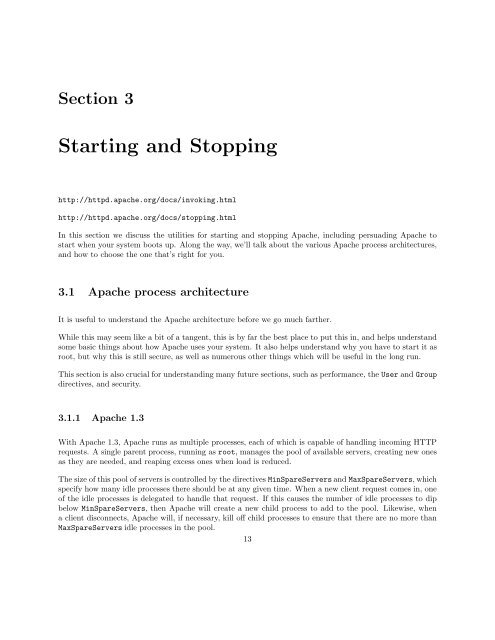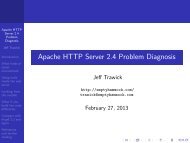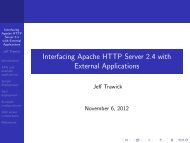Introduction to the Apache Web Server - ApacheCon
Introduction to the Apache Web Server - ApacheCon
Introduction to the Apache Web Server - ApacheCon
You also want an ePaper? Increase the reach of your titles
YUMPU automatically turns print PDFs into web optimized ePapers that Google loves.
Section 3<br />
Starting and S<strong>to</strong>pping<br />
http://httpd.apache.org/docs/invoking.html<br />
http://httpd.apache.org/docs/s<strong>to</strong>pping.html<br />
In this section we discuss <strong>the</strong> utilities for starting and s<strong>to</strong>pping <strong>Apache</strong>, including persuading <strong>Apache</strong> <strong>to</strong><br />
start when your system boots up. Along <strong>the</strong> way, we’ll talk about <strong>the</strong> various <strong>Apache</strong> process architectures,<br />
and how <strong>to</strong> choose <strong>the</strong> one that’s right for you.<br />
3.1 <strong>Apache</strong> process architecture<br />
It is useful <strong>to</strong> understand <strong>the</strong> <strong>Apache</strong> architecture before we go much far<strong>the</strong>r.<br />
While this may seem like a bit of a tangent, this is by far <strong>the</strong> best place <strong>to</strong> put this in, and helps understand<br />
some basic things about how <strong>Apache</strong> uses your system. It also helps understand why you have <strong>to</strong> start it as<br />
root, but why this is still secure, as well as numerous o<strong>the</strong>r things which will be useful in <strong>the</strong> long run.<br />
This section is also crucial for understanding many future sections, such as performance, <strong>the</strong> User and Group<br />
directives, and security.<br />
3.1.1 <strong>Apache</strong> 1.3<br />
With <strong>Apache</strong> 1.3, <strong>Apache</strong> runs as multiple processes, each of which is capable of handling incoming HTTP<br />
requests. A single parent process, running as root, manages <strong>the</strong> pool of available servers, creating new ones<br />
as <strong>the</strong>y are needed, and reaping excess ones when load is reduced.<br />
The size of this pool of servers is controlled by <strong>the</strong> directivesMinSpare<strong>Server</strong>s and MaxSpare<strong>Server</strong>s, which<br />
specify how many idle processes <strong>the</strong>re should be at any given time. When a new client request comes in, one<br />
of <strong>the</strong> idle processes is delegated <strong>to</strong> handle that request. If this causes <strong>the</strong> number of idle processes <strong>to</strong> dip<br />
below MinSpare<strong>Server</strong>s, <strong>the</strong>n <strong>Apache</strong> will create a new child process <strong>to</strong> add <strong>to</strong> <strong>the</strong> pool. Likewise, when<br />
a client disconnects, <strong>Apache</strong> will, if necessary, kill off child processes <strong>to</strong> ensure that <strong>the</strong>re are no more than<br />
MaxSpare<strong>Server</strong>s idle processes in <strong>the</strong> pool.<br />
13
















